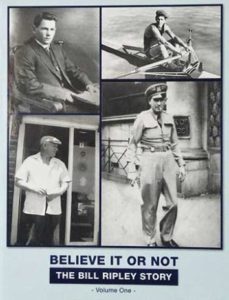- Author
- Book reviewer
- Subjects
- WWII operations, Book reviews, Biographies
- Tags
-
- RAN Ships
- None noted.
- Publication
- December 2020 edition of the Naval Historical Review (all rights reserved)
Believe it or Not: The Bill Ripley Story. By Stuart Ripley.
 In two volumes of 800 pages, these hard cover books are produced to a high standard. Available from ripleysturat@gamil.com, priced at $80 plus $20 post and packing. The author is a grandson of Bill Ripley.
In two volumes of 800 pages, these hard cover books are produced to a high standard. Available from ripleysturat@gamil.com, priced at $80 plus $20 post and packing. The author is a grandson of Bill Ripley.
The story starts with 24-year-old farm labourer Daniel Ripley and his 18-year-old wife Sarah from Yorkshire, arriving in Sydney aboard the barque Theresa in August 1842. Progressing through further generations the family establish themselves in the Hunter district. When the whole region is devastated by flood the Ripley family escape to the roof of their house and watch their possessions being washed away. A newcomer is born atop this roof on 20 March 1893 – enter Daniel William (Bill) Ripley.
Bill was schooled at Hexham but withdrawn aged nine to join the growing family business which included farming and fishing. Bill took up sculling and in 1911, aged 17, won the prestigious Parramatta Hundred Handicap with a first prize of £100, a pair of sculls and a gold medal.
Sculling was one of the earliest forms of organised sports in NSW, with teams and individuals competing for high stakes provided by local sponsors and supported by gambling. Important races attracted enormous crowds lining the river banks.
When Britain declared war on Germany in 1914 patriotic youngsters flocked to the colours. A strong and sturdy Bill Ripley volunteered only to be rejected because of flat feet and varicose veins. The dejected youngster joined G. A. Engel & Sons working on their river steamers. Most importantly he marries Mabel Engel, the daughter of one of the bosses.
Post-war Bill again took up sculling and won the NSW Championships, but realising that professional sport had eluded him he returned to command river steamers and built a home at Tea Gardens for his growing family.
In April 1942 General Douglas MacArthur established his headquarters in Australia. MacArthur and his naval counterpart Admiral Ernest King did not always agree and MacArthur thought King withheld resources. To circumvent this MacArthur set up his own mini-navy known as the US Army Small Ships Section.
The Small Ships Section were looking for anything that floated, which included two Engel vessels, and Bill nearing 50 years of age was out of a job – or was he? In September 1942 Bill was offered a position with the Small Ships Section and given command of James Wallace a 192-ton coal burning tug. Shortly after Bill joined she was converted to oil burning.
We are drawn into the exciting world of coastal navigation taking small ships with very limited navigational aids through reef strewn and poorly charted regions taking vital supplies to Allied forces as they pursue the Japanese. Bill’s ship with a string of barges is bombed and strafed by enemy aircraft, when two crew are wounded, but the supplies continue to get through. The ability of these crews, some like Bill, with limited experience outside the riverine system, should not be underestimated. They safely towed not only barges but damaged ships and floating docks through the Great Barrier Reef into the little known waters of Papua New Guinea.
With concern about the deteriorating health of Bill’s wife Mabel, he was brought ashore in August 1944 to take over the Small Ships repair base in Sydney where he remained until finally discharged on 15 November 1945.
Following the end of Bill’s war service, he retired to Tea Gardens where there was little remaining of the once thriving Engel & Sons business. Unable to be idle Bill became involved in real estate. Tragically Mabel’s illness returned and she died on 19 October 1953. Bill continued with community activities until 29 May 1970 when he succumbed to heart failure aged 77.
The author has conducted detailed research in producing a story which covers not only a family history but the early development of maritime trade on the rivers in the Hunter region, and the history of sculling is liberally covered. Possibly from a naval perspective the most compelling is Volume 2 providing first-hand experiences of the Pacific campaign from those serving in the US Army Small Ships Section. There is an ample supply of photographs and plans, many of which may not have previously been in the public domain.
Reviewed by Arcturus




